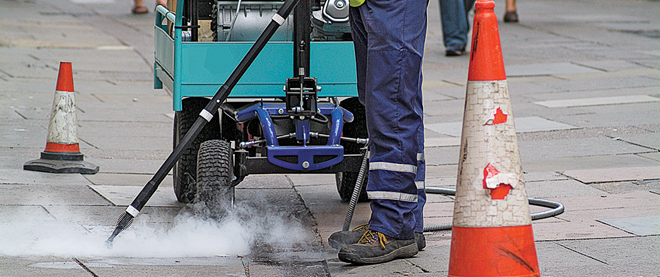Chewing gum removal is a business with big potential … or is it?
The challenge is convincing people that they do care about those black stains on the sidewalk
Guy Erwood/Shutterstock
Share

Chewing gum rarely ends up in the trash—it’s far easier to spit it out when we please, where we please. Canada’s sidewalks have become popular graveyards for gum fossils, the loonie-sized, black pancakes that remain after pedestrian trampling. One person’s trash, of course, is another’s business opportunity.
“Try removing a hardened piece of gum from the ground with a hammer and chisel,” says Adam Nelson of Gum Blasters, a Toronto-based gum removal company. “It’s impossible.” For 77 cents per square foot, Nelson removes gum with a sophisticated machine that looks like an expensive vacuum cleaner. It melts the offending blotches with 175° C steam and digests them within seconds. Gum Blasters earns around $25,000 a year for its services. Another Toronto-based company, GTA Gum Removal, expects $100,000 of business in 2012. Across Canada, where there are busy streets, there are now gum removers. Vancouver has Gum Fighters and Gum Bees.
Gum removal is a business with big potential. Market research group Euromonitor International estimates Canadians seeking better breath bought more than 15,600 tonnes of gum in 2011, worth more than $520 million. Much of that gum is littered. Still, one very big challenge stands between gum removal as a growing and lucrative industry: convincing potential customers they ought to care about those gum stains. Cities own sidewalks, but their cleaning tends to focus on more substantive trash. It often falls on individual businesses to shoulder the burden of gum cleanup. “We have to work to create demand,” says Nelson. “We have to show people that the gum is there and that they don’t want it there. I go up to store owners and say, ‘Hey, look down at that minefield of bacteria-laden splotches.’ ”
Tamero Labib, owner of a sushi restaurant in downtown Montreal, opted to eradicate the gum blighting his storefront, where his customers eat their lunch. “I noticed an immediate difference. But soon the problem comes again, and you have to keep doing it. Plus it’s expensive, you give up the space for a day to cleaning, and it smells.” Labib isn’t sure if he would keep fighting the gum fight. “It’s cleaner, that’s for sure. But to be honest I don’t think anybody notices, unless they actually see the job getting done.”
Short of a virtual ban on gum chewing (as Singapore has done) gum will continue to flourish underfoot. And cash-strapped cities appear reluctant to tackle the problem. The office of the mayor of Calgary estimates the city spends about $50,000 on gum cleaning efforts at light rail stations, but admits it is a not a high priority. “We have certainly not received a lot of citizen feedback,” says a spokesperson.
Dupray Inc., based in Montreal, estimates it sells over $1 million in cleaning equipment specifically for gum removal. Still, company spokesman Brent Gray admits even the most sophisticated gum removal machines, which retail for up to $25,000, leave a stain on the sidewalk. “That little circle on the pavement hasn’t been exposed for a long time, sometimes years, so it can leave a mark,” he says. In a way, chewing gum is the only thing keeping little bits of sidewalk clean.